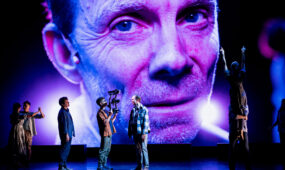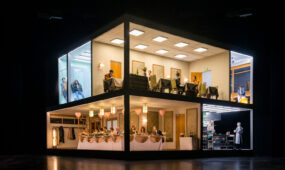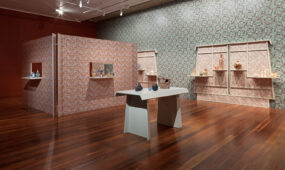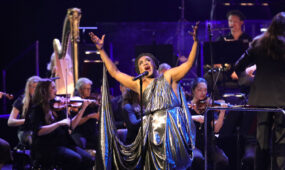Festival review: The Second Woman
Adelaide Festival
Both a feat of artistic and physical endurance, and an intricate examination of gender and vulnerability, The Second Woman was a compulsive 24 hours of intriguing theatre.

The set-up is brilliantly simple.
Actor Nat Randall – in platinum blonde wig, red dress and high shoes – is encased in a red, vaguely retro-style set of a lounge room. Two camera operators take close-ups of the action, projected on a screen on one side of the set, floating in the Space Theatre.
The audience has access to the show for a full 24 hours, in which Randall plays the same short scene, virtually non-stop, with 100 men from the community – men she has not rehearsed with, nor likely met.
The concept, inspired by the 1977 film Opening Night, results in a script of subtle ambiguity, allowing each man to play it as they see fit. The scene is the end of a troubled relationship, with a couple sharing drinks, a box of noodles each, maybe an awkward dance, with Randall’s character ultimately asking the man, “Marty”, to leave, handing him a $50 note. Each man can choose to leave with a declaration of love, or the revelation that he never loved her.
Some choose to cast themselves as the cad; others aim to be a romantic hero, sometimes breaking script. Others are difficult to read – with Randall and the audience both searching for clues. Most wear conventional street clothes – a few dress up.
Between scenes, Randall meticulously cleans the set – one of the key moments involves her, more often than not, throwing her box of noodles over Marty. Her character, in a sequence in which she is grasping for affirmation, prompts Marty, who is, depending on how it is performed, either desperately trying to list her qualities, or, in some of the men’s performances, wearily ticking off a perfunctory list: pretty, great, funny, wonderful…
“And…,” says the woman. “And ‘I love you’.”
“And you love me,” says Marty.
Not what she was looking for. It’s a pivotal moment and some of the men – who vary from young to old, tall to short, long-haired to bald – manage to make her laugh; some disgust her; some elicit tired resignation.
One older player appears delighted, exclaiming with shock: “And you love me!”, to which Randall gently drapes the noodles over his bald pate with playfulness. As other men portray it, Randall’s noodle toss is greeted with icy anger.
As the men come and go, it becomes compulsive viewing: just one more, you say to yourself. I returned three times to the theatre over the 24-hour run, from 4pm Sunday to 4pm Monday, and while Randall and the men remained consistent in their unpredictability, the audience changed its response in strange fashion.
At first, the reaction was subdued. Perhaps we were too keenly aware of the extraordinary marathon that Randall had ahead of her: the response was one of wonder. How will she pull this off? By the following afternoon, after she’d performed, unbroken for about 20 hours, the audience was more ebullient, quick to laugh at differences in the men’s performances and breaks from the script. Odd, given Randall by this stage must have been utterly sunken in fatigue – not that she looked it. Her performance remained as it had been: searching, responsive, detailed (the tipsy trip on the way to her chair from the drinks cart, unnoticed by many of the male performers).
But this is far more than a quirky theatrical stunt: among other things, The Second Woman is a meta-examination of the power of art; an intricate series of interlocking boxes unpacked over time for audience members willing to stay the journey.
Randall the actor and the character she is playing are both exposed and vulnerable, in ways which are parallel and divergent. She begins each scene facing a corner; the door opens and a man – for Randall the actor, a random man – approaches her from behind. Some touch her; some kiss her neck; some stand apart. Later in the scene, she dances, again with her back to the man – some of whom wrap their arms around her; some move against her provocatively, some awkwardly; some, again, stand aside.
In some parts of the scene, we fear for both the character and for Randall. Questions multiply. What if one of the men transgresses whatever boundaries are in place? Why are they playing the character in the way in which they choose: how much are they revealing something of themselves? Why does it ultimately feel little different when a man playing Marty tries hard to work against patriarchal type or when he offers an obviously menacing portrayal of manhood?
A compelling aspect of this show and its cumulative effect is that it prompts questions that could be answered in different ways depending on the particular dynamics of each scene, and the passing of time as Randall’s physical and emotional endurance is tested. At the same time, the central dynamic is stubbornly resistant to the efforts of the male performers – and that is the relentless, grindingly consistent, conventional notions of masculine communication and relationships.

Get InReview in your inbox – free each Saturday. Local arts and culture – covered.
Thanks for signing up to the InReview newsletter.
How Randall and co-creator Anna Breckon, who manages video direction with EO Gill, achieve these apparently conflicting outcomes is part of the genius of the show’s form, which has only been staged a handful of times (for obvious reasons) and may never be performed again.
It is both a tragedy and a triumph.
See more Adelaide Festival stories and reviews here.
Support local arts journalism
Your support will help us continue the important work of InReview in publishing free professional journalism that celebrates, interrogates and amplifies arts and culture in South Australia.
Donate Here





